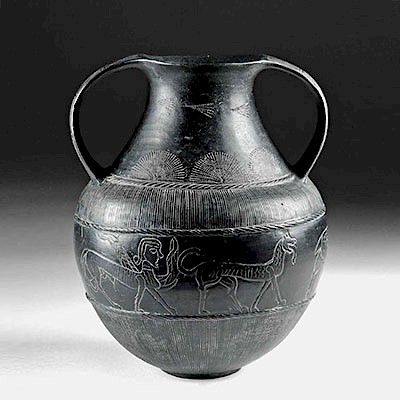Early 20th C. New Guinea Maprik Wood Lintel
Lot 206
About Seller
Artemis Gallery
686 S Taylor Ave, Ste 106
Louisville, CO 80027
United States
Selling antiquities, ancient and ethnographic art online since 1993, Artemis Gallery specializes in Classical Antiquities (Egyptian, Greek, Roman, Near Eastern), Asian, Pre-Columbian, African / Tribal / Oceanographic art. Our extensive inventory includes pottery, stone, metal, wood, glass and textil...Read more
Estimate:
$7,000 - $10,500
Absentee vs Live bid
Two ways to bid:
- Leave a max absentee bid and the platform will bid on your behalf up to your maximum bid during the live auction.
- Bid live during the auction and your bids will be submitted real-time to the auctioneer.
Bid Increments
| Price | Bid Increment |
|---|---|
| $0 | $25 |
| $300 | $50 |
| $1,000 | $100 |
| $2,000 | $250 |
| $5,000 | $500 |
| $10,000 | $1,000 |
| $20,000 | $2,500 |
| $50,000 | $5,000 |
| $100,000 | $10,000 |
| $200,000 | $20,000 |
About Auction
By Artemis Gallery
Mar 21, 2019
Set Reminder
2019-03-21 10:00:00
2019-03-21 10:00:00
America/New_York
Bidsquare
Bidsquare : Fine Ancient | Asian | Ethnographic Art
https://www.bidsquare.com/auctions/artemis-gallery/fine-ancient-asian-ethnographic-art-3967
Featuring classical antiquities, ancient and ethnographic art from cultures encompassing the globe, plus fine art. Egyptian, Greek, Roman, Etruscan, Near Eastern, Asian, Pre-Columbian, Native American, African / Tribal, Oceanic, Spanish Colonial, Russian, Fine Art, so much more! Artemis Gallery info@artemisgallery.com
Featuring classical antiquities, ancient and ethnographic art from cultures encompassing the globe, plus fine art. Egyptian, Greek, Roman, Etruscan, Near Eastern, Asian, Pre-Columbian, Native American, African / Tribal, Oceanic, Spanish Colonial, Russian, Fine Art, so much more! Artemis Gallery info@artemisgallery.com
- Lot Description
Oceania, Papua New Guinea, Abelam tribe from the Maprik/Wosera area, ca. early to mid 20th century CE. A massive wood carved lintel depicting six round, carved, anthropomorphic faces, each within a border, each separated by a hornbill head with long, downcurved beak. The two ends of the lintel feature two identical rodent-like animals with small triangular ears that lie flat on their backs. The human faces are painted with a profusion of dots and colorful shapes in red, white, yellow, and black, denoting face paint and tattooing. The lintel is pierced through in four places, in two groups of two, for suspension above the doorway of a house. Size: 8.5" W x 104" H (21.6 cm x 264.2 cm)
Dramatically carved and painted lintels like this one are part of the Haus Tambaran (an ancestor worship house with a steeply pointed roof). The Haus Tambaran is a specifically male space within the culture, and also relates to the yam cult that has developed around the staple crop of the people in this region. The faces on this example are meant to represent venerated ancestors, while the hornbills are a basic design element in much Papuan art. They are seen as symbolic of head hunting and the transfer of power. The bird also unites male and female characteristics that are important in initiation rituals.
See a similar item at the British Museum: http://www.britishmuseum.org/research/collection_online/collection_object_details.aspx?objectId=485775&partId=1
Provenance: private Newport Beach, California, USA collection
All items legal to buy/sell under U.S. Statute covering cultural patrimony Code 2600, CHAPTER 14, and are guaranteed to be as described or your money back.
A Certificate of Authenticity will accompany all winning bids.
We ship worldwide and handle all shipping in-house for your convenience.
#136148Some small chips and cracks commensurate with age, but intact and with nicely preserved pigment.Condition
- Shipping Info
-
All shipping is handled in-house for your convenience. Your invoice from Artemis Gallery will include shipping calculation instructions. If in doubt, please inquire BEFORE bidding for estimated shipping costs for individual items.
-
- Buyer's Premium



 EUR
EUR CAD
CAD AUD
AUD GBP
GBP MXN
MXN HKD
HKD CNY
CNY MYR
MYR SEK
SEK SGD
SGD CHF
CHF THB
THB














